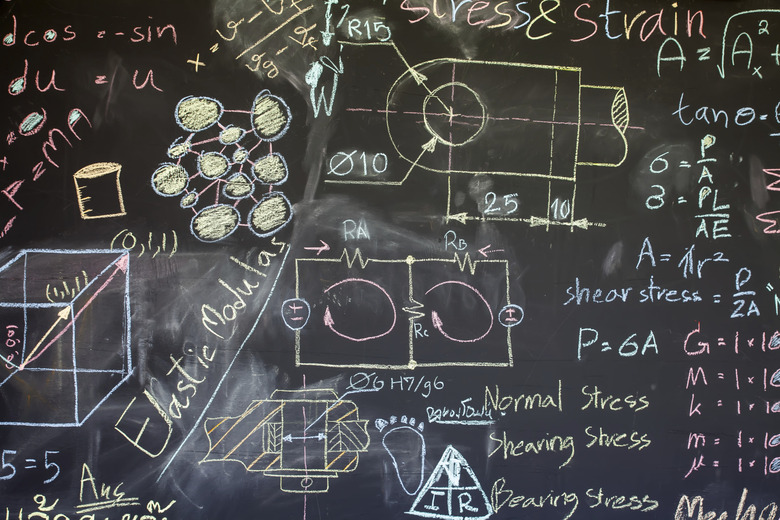Electricity Conductor Science Projects
Electrical conductivity is a material's ability to carry an electric current. Some substances — metals, for example — are better conductors than others. Whether it is for a science fair, a class project or just for fun, there are many experiments you can perform to explore the concept. Many conductivity projects use common items found around the house or items purchased at a crafts store or an electronics retailer.
Best Electrical Conductors
Best Electrical Conductors
This experiment will show which substance conducts electricity the best: metal, air, water or plastic. Place a battery and a flashlight bulb on opposite sides of a 6-by-12-inch board. Connect the positive end of the battery to one of the bulb's terminals with a wire. Connect a second wire to the battery's negative terminal, leaving the other end of the wire free. Connect a third wire to the light bulb's unused terminal, leaving the other end free. Glue a small plastic cup, metal paper clip and plastic straw to the center of the board. Put some water in the cup. Touch the free ends of the two wires from the bulb and the battery to each of the objects and note which ones light up the bulb. Hold the two pieces of wire as close together as possible without letting them touch to test the conductivity of air. Repeat each test three times and record the results.
Powerful Produce
Powerful Produce
A simple multimeter can help you determine which fruits and vegetables are the best conductors of electricity. You will need six different fruits and vegetables, such as onions, turnips, potatoes, tomatoes, oranges and lemons, as well as a pH test kit, a zinc screw, copper wire and a multimeter. Insert the copper wire and zinc screw into each end of the fruits/vegetables. Set the multimeter to the "resistance" mode, which measures electrical resistance in ohms. Hold the positive (red) multimeter probe to the copper wire and the negative (black) probe to the screw and record the reading. Disconnect the meter from the fruit/vegetable and cut the produce open. Test its pH with a paper strip from the kit and record the pH value. Repeat the steps with the other fruits and vegetables. Create a chart that shows each fruits/vegetable's pH and electrical resistance. The lower the resistance, the better the conductivity. Your chart should illustrate what fruits/vegetables conduct electricity best and how pH plays a role in the result.
Electricity and Water
Electricity and Water
The electrical conductivity of water depends on any substances that might be dissolved in it, such as salt, vinegar, sugar and baking soda. Besides these items, you will need a multimeter, a 2-cup container and a teaspoon. Use room temperature distilled water. Set the multimeter to its resistance mode. Measure the resistance of the plain distilled water with the meter's probes and record your findings. Next, measure the resistance of the other substances one at a time. Start with salt. Add about 1 1/2 teaspoons of salt to 2 cups of distilled water and test the resistance and record your findings. Add another 1 1/2 teaspoons of salt and test again. Keep adding more salt and test each time, recording your findings. Then measure the sugar, baking soda and vinegar, using the same procedure. Always record the results for comparison. Note that the lower the resistance, the better the conductor.
Electrical Conductivity of Soil
Electrical Conductivity of Soil
This experiment lets you determine the conductivity of different types of soils. You will need sand, clay and loam as well as four beakers. Dry the soil samples in an oven. Label the four beakers "sand," "clay," loam" and "loam with fertilizer." Place 200 grams of each soil type into the beakers, along with 200 ml of water. Add 50 ml of liquid fertilizer to the "loam with fertilizer" beaker. Allow the soils to absorb the water for about 30 minutes. Place two copper electrodes about 2 inches apart into one of the beakers. Connect the positive side of a milliammeter to one electrode and the negative side of a 12-volt battery to the other. Connect the unused battery post and milliammeter terminals with a third wire and note the reading. Create a table to record your findings. Repeat the process for the other samples. The soil with the highest milliampere reading has the best conductivity. You can alter the variables by adding different minerals to the soils, (as well as the amount of water, environment temperatures and pH) and compare their conductivity.
References
Cite This Article
MLA
Dumas, Robert. "Electricity Conductor Science Projects" sciencing.com, https://www.sciencing.com/electricity-conductor-science-projects-7917636/. 24 April 2017.
APA
Dumas, Robert. (2017, April 24). Electricity Conductor Science Projects. sciencing.com. Retrieved from https://www.sciencing.com/electricity-conductor-science-projects-7917636/
Chicago
Dumas, Robert. Electricity Conductor Science Projects last modified August 30, 2022. https://www.sciencing.com/electricity-conductor-science-projects-7917636/
